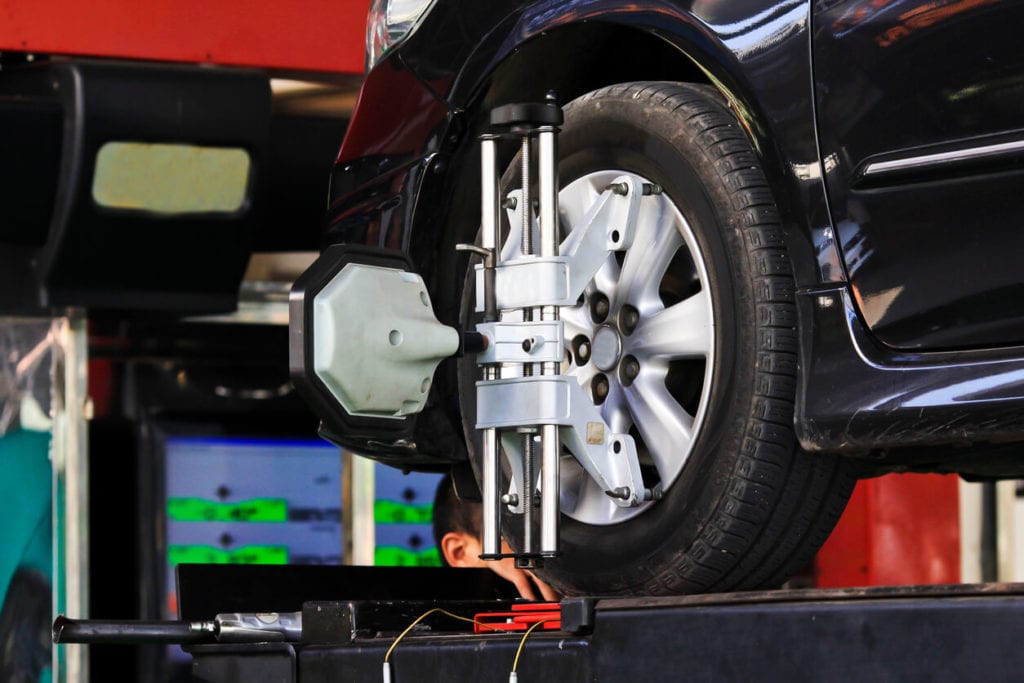 You’re driving down the road and all the while you’re fighting the steering wheel because your car seems to want to drift off to the left or right.
You’re driving down the road and all the while you’re fighting the steering wheel because your car seems to want to drift off to the left or right.
Sound familiar? It might be time for an alignment.
By getting an alignment, you’re ensuring a smoother and safer ride all while extending the life of your tires. Your car has four wheels (we hope!) and all four should be adjusted for alignment, right? Not necessarily. Your vehicle may just need a front-end alignment.
What is the difference between a 4-wheel alignment versus a front-end alignment? You might be surprised to know there isn’t much difference at all!
Front End Alignment versus Wheel Alignment
Alignment is the geometry of the suspension system that aids in supporting and turning the vehicle. Wheels must be in perfect alignment in order for all four tires to work together by rotating in unison and traveling in the same direction. A slight deviation on the spectrum can negatively affect the suspension system causing irreversible damage and premature tire wear.
A front wheel alignment, also known as a 2-wheel alignment, means the technician performing the alignment adjusts only the front wheels related to the caster, camber, and toe. The front wheels are adjusted so that they run parallel to the center of your vehicle. While this is the most simplistic alignment, this service is not recommended for modern vehicles as it excludes rear angles of the wheels.
A thrust alignment is most likely the type of alignment your vehicle will receive if it is not equipped with an adjustable rear suspension system. While only the front wheels are adjusted, they are adjusted to be aligned as closely as possible to the thrust line, where the two rear wheels are pointed. This adjustment offsets the difference to allow for a centered steering wheel.
A 4-wheel alignment is usually only performed on vehicles with four wheel independent suspension systems. The technician will adjust all four wheels however, the adjustment varies from front to rear. On the front wheels, the adjustment includes the toe, caster, and camber whereas the rear will have the toe and camber. All are adjusted to the center of the vehicle by first measuring the rear axle angles, then the front.
The Cause of Bad Wheel Alignment
There are several reasons that a car may fall out of alignment including driver error, worn suspension components, and driving conditions. While made of metal, the components in the suspension system are not impervious to damage and are vulnerable to blows from potholes and curbs.
Impacts that occur, at any rate of speed, can make minor adjustments to the shape of the wheel that impact alignment. Similarly, over time the suspension components begin to breakdown and crack or become loose, losing their ability to keep wheels aligned. Lastly, poor wheel alignment can be caused by vehicle modifications. Automotive manufacturers specifically calculate suspension by the vehicle’s height. Modifications must be adjusted to compensate for the change in height.
Why You Shouldn’t Drive with Bad Alignment
Driving with poor wheel alignment is not only an annoyance, but it can also affect your wallet. Driving with poor alignment may force you to purchase new tires sooner than expected, increase fuel intake, and may require costly repairs to the suspension system.
Plus, driving at high speeds with poor alignment can affect your ability to steer, placing your safety at risk. Wheels that need to be aligned often pull to one side, causing drivers to increase their grip on the steering wheel to maintain control of the vehicle. Poor alignment also makes handling and braking more difficult.
Reasons Why You Shouldn’t Drive with a Misaligned Vehicle:
- Difficulty braking – Wheels that are unable to travel or turn in the same way are also unable to brake evenly.
- Poor fuel economy – Wheels that are misaligned cause tires to drag instead of rolling smoothly, reducing fuel efficiency by up to 10%.
- Tire damages – While traveling at highway speeds, a vehicle that is misaligned places excess pressure on the tire that may cause a tire to blowout and put your safety at risk.
- Severe shaking or vibrations – Wheels that are not aligned do not turn in the same direction and cause uneven tire wear, causing vibrations on the road.
- Difficulty handling – Wheels that are not in line affect your ability to properly maintain control with the road and the handling of your vehicle, risking your safety.
Did you know front-end or 4-wheel alignments can be performed in as little as one hour on most vehicles? Protect your vehicle’s suspension and tires by having a wheel alignment performed on your vehicle at your local Sun Auto Service. Our qualified technicians, utilizing the most sophisticated alignment machines, will ensure your vehicle is aligned to the specifications set forth by your vehicle manufacturer. By having your wheels aligned, you’ll save money from the expense of having to purchase new tires prematurely, costly suspension repairs, and multiple trips to the pump. Schedule your front-end or 4-wheel alignment with Sun Auto Service today!
